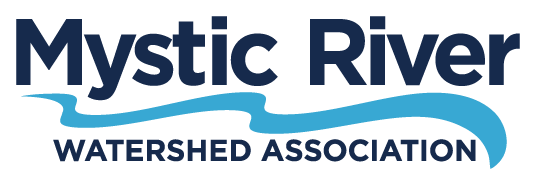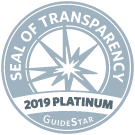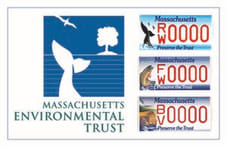The Mystic River Watershed Association is excited to announce that Boston-based multidisciplinary artist Andres Duarte has joined MyRWA as our Mystic River Artist in Residence from now until spring 2026. The Mystic River Artist in Residence Program is grounded in the belief that creative projects offer unique opportunities to help people connect with and learn about the natural world, making outdoor spaces more accessible and welcoming, and empowering communities to work together to protect and restore the natural resources around us. We are thrilled to have Andres join us as a collaborator toward this vision.
Karen Buck (left) from Friends of the Malden River gives Andres (right) a tour of the Malden River Works project site. Photo: Sushant Bajracharya
Andres navigates in both English and Spanish, so our introductory Q&A is in both languages:
Q: Tell us a little bit about yourself. What do you want to share about your background?
Cuéntanos un poco sobre ti. ¿Qué quieres compartir sobre tu experiencia?
A: I am an artist and urban designer born in Bogota-Colombia, a city where I experienced the rudeness of a big gray city — full of cars, traffic, inequity, not easy access to green areas, but with a strong movement of public and street art that showed me a different way to live and understand the relationship between the public space and the community. It is from here that I found a way to express and contribute to developing a better society that shows respect for everyone.
Since moving to Boston in 2021, I’ve had a desire to connect to and be a part of the community. It has been the perfect complement for my artistic practice, giving me the opportunity to connect not only with more cultures and people but also with different perspectives and understandings of society, which helps to expand the kind of interventions in my practice as an urban artist.
Soy un artista y diseñador urbano nacido en Bogotá-Colombia, ciudad donde experimenté la rudeza de una gran ciudad llena de concreto, carros, tráfico, inequidad y difícil acceso a las áreas verdes pero que al mismo tiempo con un fuerte movimiento de arte callejero que me brindó la posibilidad de vivir y entender la relación entre el espacio público y la comunidad de una forma differente. Es desde acá donde encontré una forma de expresar y contribuir al desarrollo de una mejor sociedad que muestre respeto por los demás.
Desde mi llegada a Boston en el 2021, despertó un deseo de conectar y ser parte de la comunidad, situación que se convirtió en el perfecto complemento para mi práctica artística al darme la oportunidad no solo de conectar con más culturas y personas, sino que a su vez explorar las diferentes perspectivas y entendimiento de la sociedad, que sirvieron para expandir el tipo de intervenciones en mi práctica como artista urbano.
Q: What has your approach to making art been? What mediums do you work in and what themes do you like to explore?
¿Cuál ha sido tu enfoque a la hora de hacer arte? ¿En qué medios trabajas y qué temas te gusta explorar?
A: I create artistic interventions in many different ways, from being a bike activist — making murals and tactical urbanism in spaces in critical condition — to making an “art festival” where artists from different parts of the world contribute toward uniting the community.
Creo intervenciones artísticas de muchas maneras diferentes, desde ser un activista por la bicicleta con el desarrollo de murales y urbanismo táctico en espacios en condiciones críticas, hasta la realización de “festivales artísticos” donde artistas de diferentes lugares del mundo tiene la posibilidad de contribuir a la unión de la comunidad.
Q: Why were you interested in this residency in particular? What about working with a watershed organization excites you?
¿Por qué te interesó esta residencia en particular? ¿Qué le entusiasma de trabajar con una organización de cuencas hídricas?
A: I think that a watershed is a good example of coming together — a way of connecting — different spaces, and species, that live there. In this case, species also refers to the communities and cities around the river.
At the same time, a watershed is an example of resilience and change, that could bring me a better understanding of society and its adaptation to difficulties.
Creo que una cuenca hídrica es un buen ejemplo de reunir — una forma de conectar — diferentes espacios, y especies que viven allí. En este caso especies también se refiere a las comunidades y ciudades alrededor del río.
Al mismo tiempo una cuenca hídrica es un ejemplo de resiliencia y cambio, que puede llevarme a un mejor entendimiento de la sociedad y su adaptación a las dificultades.
Q: What are your goals in bringing art to the Mystic?
¿Cuáles son tus objetivos al llevar el arte al Río Mystic?
A: To present to the community a "bridge" that allows people to:
Connect and unite around the understanding of their environment
Learn about caring for the river and themselves
Offer new ways to have fun and enjoyment around the river
Presentar a la comunidad in puente que permita :
Unir y conectar alrededor del entendimiento de su medio ambiente
Aprender del cuidado del río y de ellos mismos.
Presentar una nueva forma de disfrutar alrededor del río
Q: What do you like to do in your free time?
¿Qué te gusta hacer en tu tiempo libre?
My love for music has led me to practice DJ-ing, which has become my favorite hobby. It’s a special time to share with friends, dance, and express a little more of my Colombian roots. However I can’t leave out that every time that I have the opportunity to visit my house in the green mountains in Colombia, I take it. It is the place that recharges me and brings me peace.
Mi amor por la música me ha llevado a la practica de DJ, situación que se ha convertido en my pasatiempo favorito. Es un tiempo especial para compartir con amigos, bailar y expresar un poco más de mis raíces Colombianas. No puedo dejar por fuera el placer que me da visitar mi casa en las montañas de Colombia, lugar que se ha convertido en la fuente de recarga energética y paz.
The Mystic River Artist-in-Residence Program is part of the nationwide U.S. Environmental Protection Agency (EPA) Artist-In-Residence (AIR) Pilot Initiative in partnership with the National Endowment for the Arts (NEA). The EPA Artist in Residence Program supports a broad range of local artists and culture bearers in six geographic areas within National Estuary Programs (NEP) and Urban Waters Federal Partnership (UWFP) locations, including the Mystic River Watershed Urban Waters Federal Partnership: Massachusetts Bays National Estuary Partnership.






